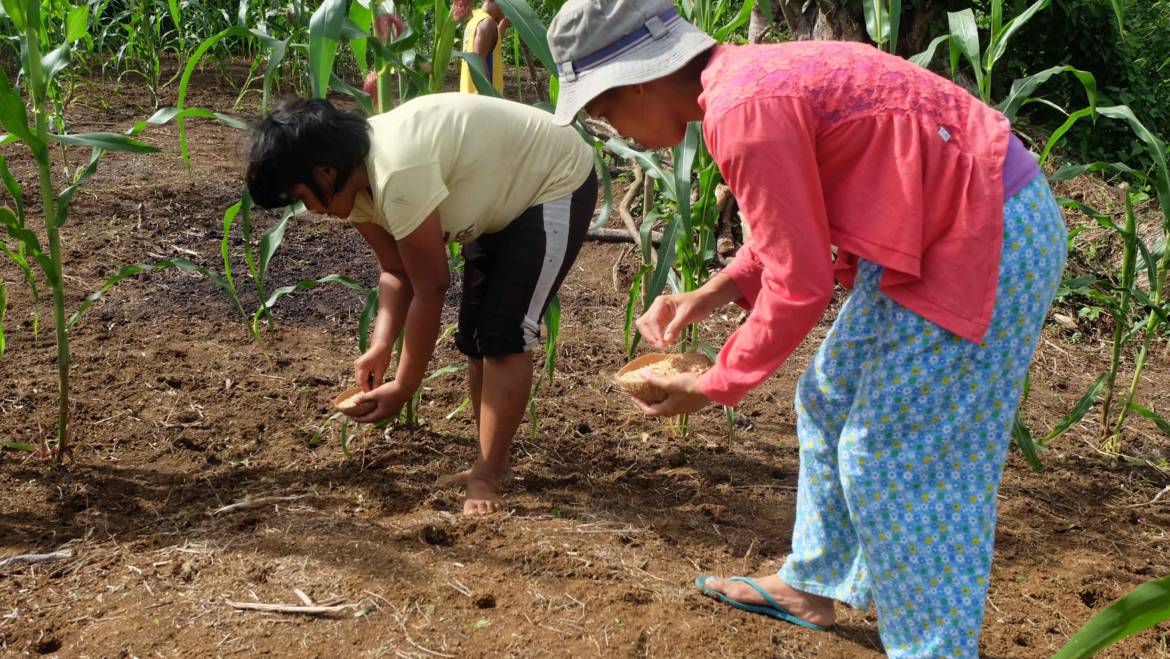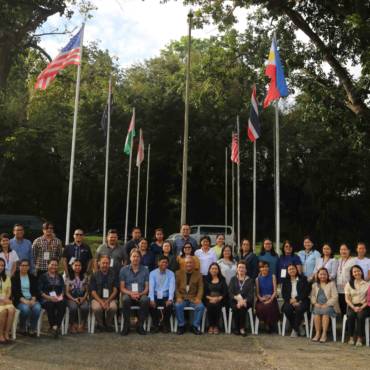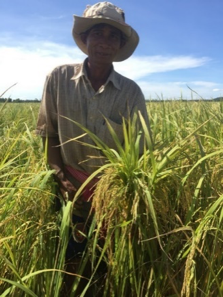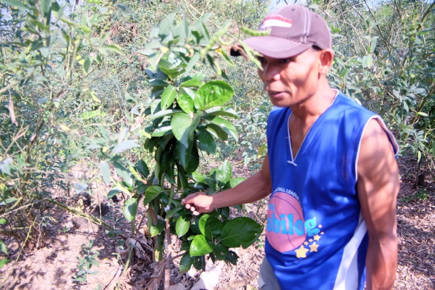Climate-Smart Villages in the Philippines: Scalable platforms for local adaptation initiatives
By Kimmy Baroidan[1]
Agriculture accounts for one third of the employment in the Philippines, making it a key sector. The International Food Policy Research Institute (IFPRI) estimates that the agricultural impacts of climate change would cost the country 26 billion pesos per year through 2050. Being a developing country, the Philippines cannot afford such big losses. Smallholder farmers are the most vulnerable and at risk to the impacts of climate change on livelihoods, food security, and nutrition in rural areas.
At a global level, agriculture, together with land use and forestry, contributes to one third of all greenhouse gas (GHG) emissions, a significant driver of climate change. However, agriculture can also be part of the solution offering many opportunities to mitigate GHG emissions. Climate-resilient or climate-smart agriculture (CRA/CSA) is one of these opportunities[2]. With an appropriate approach, CRA/CSA can also effectively deliver on food security, nutrition, and livelihood development goals. Well-designed programs can also address the differential impacts that climate change is having on women. Local governments play a pivotal role as a platform for delivery of local solutions.
According to FAO, CRA/CSA entail greater investment to manage risks, understand and plan for possible adaptive transitions towards new farming systems or livelihoods, and exploit opportunities for reducing or removing GHG emissions, where feasible. Its principles are adopted in the Philippines through the Department of Agriculture Systems-Wide Agricultural “Climate Resilient Agriculture” as the national framework for adaptation and mitigation in agriculture and fisheries.
Community Based Adaptation and Local Government Platforms for local level climate action:
Starting with a small grant from the CGIAR Research Program on Climate Change, Agriculture and Food Security (CCAFS) in 2015 and later in 2016 via a larger grant (undertaken in partnership with the World Agroforestry Centre (ICRAF)), the International Institute for Rural Reconstruction (IIRR) initiated a local government-level platform for developing a proof-of-concept site of how to facilitate community-based adaptation and livelihood resilience building.
The CCAFs-supported research is built on the current knowledge base for undertaking gender-sensitive community-based adaptation (CBA).[3]Community-based adaptation is viewed as a way of engaging local communities in addressing climate change risks. This increases the chances for horizontal farmer-to-farmer diffusion of ideas. CBA is a useful mechanism for local governments to become engaged in climate-smart agriculture (CSA) that is responsive to both climate risks and local livelihood priorities. This testing of local level interventions relies on participatory action research (PAR). Social learning methods & participatory approaches were used to generate knowledge about methods and approaches for identifying and developing (local) funding and for outscaling. Proof-of-concept sites were established to serve as platforms for CSA advocacy to support out scaling of CSA & CBA at sub-national levels. Methodologies were developed to help facilitate various scales of wider promotion of CSA adoption and community-based adaptation from village to sub-national levels, ultimately targeting scaling interventions of national relevance such as policy-influencing activities (e.g. roving workshops, field visits, conduct of roundtable events and knowledge management activities, media engagement, etc.).
A heavy reliance on information education was featured over the past three years. This included the development of primers for informing/educating decision makers. Primers served as prototypes for translation or adaptation to local audiences especially local government officials.[4]Their adaptation and subsequent translation have occurred in Cambodia, Vietnam and Myanmar.[5]
Media engagement is considered important in bringing CSA and the concepts of community-level adaptation and CSV platforms to the wider public. Participation in round table events and visits to CSV sites have contributed in enriching the understanding of community level, local adaptation efforts in IIRR’s work .The role of media advocated by CCAFs in the region also received considerable attention for influencing the information environment of the public including decision makers and educators.[6]A rich range of blogs, newspaper coverage, and video coverage in the Philippines ensued as result of this extraordinary emphasis on public education and awareness. In the Philippines, CCAFs has succeeded in engaging the Philippine Agricultural Journalists in promoting issues related to climate change and opportunities for CSA in adaptation efforts.
IIRR has viewed capacity development (targeted to different audiences at different levels) as a scaling approach. Well-designed capacity development efforts, which rely on strong conceptual elements, accompanied with proven and actionable ideas, is in itself an effective scaling mechanism. Capacity development featuring exemplary practices from the two IIRR CSVs and government research for development partners helped provide effective and innovative training. These were targetted to the Department of Agriculture’s System-Wide Climate Change Office (DA-SWACCO) and local government executives.The approach advocated multi events for the same group, with incremental inputs over months and years. This is what IIRR does with the Department of Agriculture to promote the CSV type of engagement in the department’s Adaptation and Mitigation Initiative in Agriculture (AMIA) villages. CSV are viewed as platforms for scaling and sustaining CSA.
Multiple sites help maximize the learning opportunities provided by a CSV
To be effective in supporting scaling objectives, there is a need for adaptive research sites to feature a diversity of agroecologies and livelihood activities. Consequently, the CSV project in the Philippines featured multiple sites within a municipality, illustrating a portfolio of CRA/CSA options. The project helped develop an evidence base for how local-level and sub-national outscaling of climate-resilient agricultural practices can be undertaken under different conditions. Loosely defined, a CSV could be an entire municipality with a number of geographic and agroecological sites. Such approach is likely to be acceptable to local government authorities, which have broader mandates to deliver outcomes on scale (unlike a research and development organization with relatively narrow mandate).
The CSV in Guinayangan featured sites in contiguous villages for enhanced impacts, representing a range of agroecologies (from forestlands down to lowland rice-based ecosystems and coastal fishing communities).Ten barangays(villages) were initially covered by action research efforts. These contiguous barangaystraverse the Hiwasayan River, the major river system of Guinayangan. They represent major agricultural systems in the municipalities: Barangays Sta. Cruz, Ermita, and San Roque are dominated by upland coconut-based agro-ecosystems; upland Barangays Himbubulo Weste, San Pedro I, and Magsaysay are located adjacent to the town’s major watershed protection area, the Maulawin Spring Protected Landscape; Barangays Sintones, Ligpit Bantayan, Dancalan Central, and Arbismen have lowland agro-ecosystems, and coastal Barangays Dancalan Central and Arbismen are engaged in fishing and coastal agriculture.
Participatory and farmer-centered approaches were featured.[7] Impact areas served focal areas where proof-of-concepts of both CSA technologies and practices as well as farmer-to-farmer scaling out approaches are generated. The impact areas are designed to serve as on-site learning platforms on CSA practices and are characterized by the following: contiguous areas (at least 2 adjacent sitios or hamlet) with relatively wide scale practice of specific CSA practices are noted (traditional or introduced); the presence of community-of-practice or a critical mass of CSA practitioners such as common-interest groups (self-help groups) engaged in CSA practice; and the presence of institutional support mechanisms from local government as well as other development actors. Impact sites are not all attributed to IIRR or CCAFs but nevertheless emerged as a result of the project’s advocacy efforts.Impact sites are important elemenst of the social learning methods tested and derived in the CSVs.
In the Guinayangan CSVs, six impact sites emerged in three years:
Impact Area 1:Watershed Management in Forest Ecosystems includes CSA work such as the promotion of multi-storey cropping in the multi-use zone area (Agroforestry), community forest management using a multi-stakeholder structure, and modelling of the concept of payment for environmental services (PES) in cooperation with the local water district provider. Small landscapes work with aspects of climate change adaptation was featured here.
Impact Area 2:Low External Input in Lowland Rice-based Ecosystems features the introduction and participatory testing of stress tolerant rice varieties from Phil Rice, the diversification of rice-based systems, and reduction of GHG through better management and integrated nutrient management.
Impact Area 3:Agroforestry in the Upland Coconut-based Ecosystems features crop diversification to increase the mitigation potential of Guinayangan’s uplands.[8]This includes fruit, cacao, and coffee trees, which have direct economic empowerment contributions. The use of microclimate manipulation methods (boundary tree planting of gliricidia and multistrata tree combinations) were viewed as an important CSA method. Processing of smallholder coffee also received attention.
Impact Area 4:Intensified cassava and roots and tuber crops (RTCs) production in upland coconut-based ecosystems features wider-scale introduction of cassava and RTCs in coconut systems. This effort helped scale out the introduction of drought tolerant root crops in at least three villages.
Impact Area 5:Small-scale low external input in livestock production to diversify livelihood sources of farmers relying on low carbon foot print methods of pig raising, use of resilient but improved native pig breeds, and the establishment of decentralized pig and goat propagation centers and alternative feed measures.[9]
Impact Area 6:Resilience building through coastal bio shields through enhancement of coastal forest cover and information campaigns.[10]This included a bigger role on homestead agriculture using species tolerant to salinity and coastal environments (sandy soils, etc.).
Engaging agricultural research centers and universities: fostering linkages with farmers and community level action
A key element in the strategy used in the Philippines is the engagement of local research establishments in supporting local adaptation work of local governments, thus bringing science to bear more directly to problem resolution. At least seven agricultural research centers and two universities were engaged in capacitating Guinayangan CSVs, thus demonstrating the value of linking science and research to action research.
- National Swine and Poultry Research and Development Center(NSPRDC) in Tiaong, Quezon – provides series of trainings on native pig raising, improves pig raising practices, and serves as source of good quality breeder of five best native breeds in the Philippines. This initial work has now received major support from the Department of Agriculture, further fostering scaling of low carbon footprint approaches to pig production.
- Philippine Root Crops(PhilRootCrops) – the lead technical advisor and resource institution on intensive cassava production, cassava-based value chain development and helping in developing linkages with potential markets. Two villages have now become major producers of cassava and sweet potato relying on initial introduction of materials sourced from PhilRoot Crops, Leyte.
- Southern Tagalog Integrated Agricultural Research Center(STIARC) in Lipa, Batangas – exploratory meeting on possibility of conducting Community-based Participatory Action Research (CPAR) on specific commodities in Guinayangan.
- Institute of Plant Breeding Institute (IPB)of the University of the Philippines in Los Baños, Laguna – source of quality planting material especially open pollinated corn. The first improved corn varieties in the municipality were secured from IPB. Since then the municipality has developed three focal areas for corn production attracting investment from the provincial agriculturist.
- Cagayan Valley Integrated Agricultural ResearchCenter (CVIARC) – serves as source of quality planting materials and the resource institute on peanut and corn production. The reintroduction of peanut within the municipality relied heavily on four locally adapted varieties of peanut secured from CVIARC.
- Philippine Rice Research Institute(PhilRice) provided stress tolerant rice varieties to support the participatory varietal trials undertaken in the CSV. PhilRice sends its staff to conduct training on upland rice technologies and seed banking.
- The National Coffee Research Development and Extension Center (NCRDEC) at Cavite State University, Indang undertook suitability mapping for coffee and provided training on coffee production.
- The Central Luzon State University – served as a resource institution, a learning venue for innovations in agricultural production, and a source of goat breeds for the propagation center in Guinayangan CSV.
- The College of Forestry and Natural Resources of the University of the Philippines, Los Baños –served as resource institute on watershed management and protection and supplied cassava planting materials and fodder grasses and trees.
CSV outcomes and public goods: nurturing new investment in CSA/CSV and related work
- Commodity and theme-based learning groups were actively engaged in generating knowledge on CRA/CSA technologies and adaptation planning. Community-based vulnerability analysis, information campaigns, sensitization activities, and capacity-building of farmer learning groups utilizing farmer-to-farmer extension approaches were facilitated. A community adaptation fund was developed and operationalized to support decentralized farmer-led experimentation, innovation, and scaling out of CRA/CSA practices. The Department of Agriculture recognized IIRR’s work of testing CSV approaches in the Philippines (ICRAF-F2-SEA-P55 project), thus tapping IIRR as an implementing partner in its AMIA program. The Department of Agriculture, through the DA-BAR, invested USD100,000 to further develop Guinayangan CSV as a CSA learning site; and another USD100,000 for IIRR’s Ivisan, Capiz project site for same purpose. These sites were used to train regional AMIA teams, particularly in facilitating community-based CSA work and establishing AMIA villages, the country’s adaptation of CSV, in 17 regions.
- The role of media in influencing the information environment of the public, decision makers, and educators also received considerable attention.[11] A rich range of blogs and newspaper and video coverage in the Philippines ensued as result of this extraordinary emphasis on public education and awareness.[12]
- One important social learning approach proven useful in the Philippines was the roving workshop method. It provided on-site and experiential learning to community leaders and field researchers and provided opportunities for participants from different provinces to share and reflect on the role of CSA in achieving and sustaining community resilience. Adaptation and mitigation measures in the agriculture and fisheries sector were demystified by introducing and facilitating community-based adaptation (CBA) mechanisms. From 12 to 13 November 2015, 17 farmers from 6 barangays in Guinayangan together with the OMA technician and IIRR and local government staff attended the roving workshop for coffee and cacao farmers.[13]Other social learning approaches conducted wereparticipatory vulnerability analysis, community adaptation funds and decentralized support services, the use of learning groups units for action researches.
- The concept of roving workshops was first tested within the CCAFS Southeast Asia region in the Philippines, which subsequently served as model for other CCAFS countries like Vietnam[14], Cambodia (14 to 18 August 2017), and Laos.[15] The IIRR-introduced methodology is used as a mechanism for cross-learning across different agroecologies, landscapes, and socially differentiated groups. The roving workshop methodology will be used in an international CSA event featuring IIRR’s work in the dry zone, delta, and uplands of Myanmar on November 2019.
- The incorporation of CRA/CSA into the local government’s agriculture extension services and farmer union is expected to benefit around 5,000 farmers in all 54 villages of Guinayangan. Agriculture offices in 10 nearby municipalities plan to replicate CRA/CSA interventions that could directly and indirectly benefit 50,000 farmers. In addition, two other municipalities in the country (Ivisan, Capiz and San Francisco, Quezon) are being considered as outreach areas. Guinayangan is now recognized as a learning site, which influences the implementation and rollout of the Department of Agriculture’s AMIA program. The project has now surpassed its target of engaging 16 new local governments within the year for CSA promotion. On-site and off-site farmer-to-farmer learning and CSA promotion to village and municipal local governments have resulted in the uptake of CSA practices in eight new villages within Guinayangan and 13 villages in the municipality of Ivisan in Capiz Province. The total number of village-level local governments engaged in the project in Guinayangan is now 18, eight of which are considered as scaling out areas as these are located outside the villages covered by the project. In Ivisan, the local governments of 13 villages, along with the municipal local government, have adopted the strategy of widely promoting CSA among its farmers and developing Ivisan as a learning platform for CSA in the province.
- Through this project, 1,000 farmers from 15 villages in Guinayangan were reached. Twelve CRA/CSA options were tested by 241 farmers through 12 farmer learning groups: (a) rice-based technological options,[16](b) coconut-based technological options,[17](c) livestock and poultry-based technological options, (d) technological options for coastal communities, and (e) corn and upland rice in sparsely vegetated uplands. CSAs and CSV platforms proved beneficial to the farmers, increasing their profits and helping them become self-sufficient.[18]
- Various publications were crafted from the knowledge generated from the project. These included CRA/CSA primers (translated into different languages),[19]field guides and manuals for local stakeholders,[20]case studies, and other related knowledge products.[21]Portfolios of CRA/CSA technologies tested and promoted in Guinayangan are now available.[22]This approach of CSA portfolio development is based on field-level testing of approaches (rather crop suitability mapping) that the local and provincial government can identify. Participatory Vulnerability Analysis and Climate Risk Mapping, undertaken at the lowest level (municipalities and villages), are viewed as complementary to national level suitability mapping efforts.[23]
- The pioneering work in establishing the Guinayangan CSV in Quezon served the wider community, including the DA-RFOs, in planning the operationalization of the DA AMIA framework to establish AMIA villages through its Systems-Wide Climate Change Office (SWCCO).[24] AMIA villages (which are similar to CSVs) are testing grounds for CRA/CSA where food and nutrition security, livelihoods, income, and nutrition are important dimensions. They are platforms for multi-stakeholder participation and collaborative work. The bulk of the roving workshop involved visiting established impact sites. In partnership with the University of the Philippines Los Baños Foundation, Inc. (UPLBFI), several roving workshops were organized in 2017 and 2018 to support the Department of Agriculture. A roving workshop was held from 16 to 18 October 2017 in Guinayangan, where selected officers and staff of selected DA Regional Field Offices (DA-RFOs) learned about CRA/CSA tools and approaches.[25]The Department of Agriculture has further requested the support of IIRR in 2019 to review and support capacity strengthening of the DA RFOs in the area of climate resilient agriculture, programming for climate resilient villages, and community-based adaptation and associated social learning approaches for all the 17 regions of the country. In 2019, building on the related work undertaken by CIAT (vulnerability mapping and climate information systems), IIRR will intensify its capacity development, technical monitoring, and knowledge management support to the DA-SWCCO.[26]
- The participatory action research work in the Philippines undertaken by IIRR, with the support of CCAFS and the DA-SWCCO/Bureau of Agriculture Research, had outcomes in other countries including Cambodia, where IIRR was able to secure a grant from ADB for climate-smart agriculture and related infrastructure and capacity building work in Cambodia via a project grant (#0426 for $900,000)[27]for implementation in two provinces, Koh Kong and Mondulkiri. The design of the project was substantially influenced by the learning derived from the Guinayangan site with CCAFs support. The idea of primers first developed with CCAFs support was subsequently introduced and adapted to Cambodia, featuring climate smart agriculture concepts, principles, and practices.[28]From March 28 to April 4 2019, further explorations will be undertaken with donors in Cambodia interested to invest in climate change adaptation work in different agroecologies. Scoping studies were already completed and first draft reports for three potential CSVs in Kandal, Koh Kong, and Mondulkiri, each with distinct agroclimatic profile, have been completed.[29] Exchangeswith existing CCAFs CSV in Cambodia will also be explored in 2019. Increased investment in CSA work is now already noted in Cambodia.
- IDRC Canada supported a 3-year proposal in Myanmar ($575,000 for 2018-2021) supporting the establishment of CSVs in 4 distinct agroecological zones.[30]IIRR’s work in Myanmar will feature climate adaptation work in a prominent manner engaging the government and Yezin Agricultural University.[31]The rationale for advocating for CSVs in Myanmar was based on the experience gained in the Philippines. CCAFS supported the initial scoping missions in four different ecosystems and co-funded two roundtable events on CSA and Nutrition Sensitive Agriculture in Myanmar, leading to the interest of IDRC to invest in the CSV approach. The CSV approach in Myanmar[32] has stronger linkages between climate change adaptation, nutrition, and gender than the original CSVs in the Philippines as result of the evolution of knowhow on how to do this. The need for culture specificity also is somewhat unique in the Myanmar work.[33]IIRR’s works in Myanmar and Cambodia have resulted in linkages established with CIAT in the area of Climate Information Systems.[34].This additional investment is viewed as an endorsement of IIRR’s engagement in Climate Adaptation work initially nurtured by CCAFs.
__________________________
Footnotes:
[1]Ms. Kimmy Baroidan is a professional photojournalist and communication specialist from Los Baños, Laguna, Philippines. She holds a Bachelors degree in Development Communications. She contributes to the Philippine Daily Inquirer, a national daily and Laguna NOW, a local newspaper.
[2]Michael Makabenta Alunan, Climate Change is Real but Don’t Blame Humans. Business Mirror (Opinion/Column). February 28, 2017 http://businessmirror.com.ph/climate-change-is-real-but-dont-blame-humans
[3]Julian Gonsalves et al., Climate resilience in agriculture: Key concepts for community-based adaptation. https://hdl.handle.net/10568/79434
[4]Julian Gonsalves et al. 2015. Climate Smart Villages: Key Concepts. Hanoi, Vietnam: CGIAR Research Program on Climate Change, Agriculture and Food Security (CCAFS). https://hdl.handle.net/10568/69005;Gonsalves J,et al. 2015. Climate Smart agriculture: a primer for local government officials in the Philippines. Silang, Philippines: International Institute of Rural Reconstruction (IIRR), World Agroforestry Center (ICRAF) and CGIAR Research Program on Climate Change, Agriculture and Food Security (CCAFS). https://hdl.handle.net/10568/68835;
[5]Julian Gonsalves et al. 2015. Climate Smart Villages: Key Concepts. Hanoi, Vietnam: CGIAR Research Program on Climate Change, Agriculture and Food Security (CCAFS). https://idl-bnc-idrc.dspacedirect.org/bitstream/handle/10625/57253/57314.pdf
[6]Johnny F. Goloyugo,Southeast Asian media action needed to communicate climate change. Business Mirror (Features/Science). October 22, 2017. https://businessmirror.com.ph/2017/10/22/southeast-asian-media-action-needed-to-communicate-climate-change/
[7]Linda Bolido. “Farmers learn to cope with climate change.” Philippine Daily Inquirer.http://newsinfo.inquirer.net/877364/farmers-learn-to-cope-with-climate-change
[8]IIRR. Agroforestry for a changing climate. https://www.dropbox.com/s/thibp11ixltq1jy/Agroforestry%20Brief%20Third%20Draft%20%208Feb2019.pdf?dl=0
[9]Julian Gonsalves et al., Climate Smart Agriculture: Models for Empowering Women Livestock Producers. 2015-2018 Outcomes. January 2019. https://www.dropbox.com/s/l5sw09dko81uh9l/Native%20Pigs%20Brief%20Third%20Draft%20%208Feb2019.pdf?dl=0
[10]Julian Gonsalves et al., Resilience Building andClimate Change Adaptation forCoastal Communities (Model building for small municipalities in the Philippines). 2015-2018 Outcomes. January 2019. https://www.dropbox.com/s/dneq3gglxvlqcjb/Coastal%20Agri%20Brief%20Third%20Draft%20%208Feb2019.pdf?dl=0
[11]Johnny Goloyugo. “Southeast Asian media action needed to communicate climate change.” Business Mirror. https://businessmirror.com.ph/southeast-asian-media-action-needed-to-communicate-climate-change/
[12] UN CC:Learn, “Stories from the Philippines”, Video, Youtube.com, https://youtu.be/KxHVzjCs7eA
[13]Ruel Jordan. “Roving workshop for coffee and cacao technologies.” Prolinnova. https://prolinnova.net/sites/default/files/documents/philippines/celebrating_international_farmer_innovation.pdf
[14]Amy Cruz. “Southeast Asian farmer leaders learn about climate-smart agriculture in Vietnam.” CCAFS. https://ccafs.cgiar.org/news/southeast-asian-farmer-leaders-learn-about-climate-smart-agriculture-vietnam#.WurMfKSFPIU
[15]Eisen Bernardo. “Developing climate-smart farmers using knowledge-sharing and on-site learning approaches.” CCAFS. https://ccafs.cgiar.org/blog/developing-climate-smart-farmers-using-knowledge-sharing-and-site-learning-approaches#.WurN46SFPIU
[16]Prime Sarmiento. “In search of diet and climate-friendly rice.” Business Mirror. https://businessmirror.com.ph/in-search-of-diet-and-climate-friendly-rice/
[17]Pia Ranada. “A ‘green revolution’ that may save Filipino coconut farmers.” Rappler.https://www.rappler.com/science-nature/environment/120326-agroforestry-intercropping-coconut-farmers-quezon
[18]Jhesset Enano. “Climate-smart farms yield bigger profit.” Inquirer.net. http://business.inquirer.net/215176/climate-smart-farms-yield-bigger-profit
[19]Climate resilient, high value, intensive vegetable production. Climate smart agriculture (CSA) technology portfolios for rice-based systems (saline, upland, and lowland ecosystems). Developing scalable approaches for community-based adaptation: a brief. Homestead agriculture in drought and salinity affected areas addressing climate resilience livelihoods and nutrition challenges.
[20]Gonsalves J; Campilan D; Smith G; Bui VL; Jimenez FM (Eds.). 2015. Towards Climate Resilience in Agriculture for Southeast Asia: An overview for decision-makers. Hanoi, Vietnam: International Center for Tropical Agriculture (CIAT). CGIAR Research Program on Climate Change, Agriculture and Food Security (CCAFS). 450 p. https://hdl.handle.net/10568/71100
[21]CIAT. 2016. Climate Resilient Agriculture: educational/training posters series. Cali, CO: International Center for Tropical Agriculture (CIAT). 34p. https://hdl.handle.net/10568/71099
[22]IIRR. 2017. Towards a portfolio of climate resilient technological options: Community level participatory adaptive research. https://www.dropbox.com/s/ee0z8udru61ilac/Climate%20resilient%20technical%20options%20primer.pdf?dl=0
[23]Climate risk maps in Ivisan, Capiz can be found here: https://drive.google.com/drive/folders/18h0ANKNPNfdhE9O6hxiYn0NudwvCa392
[24]Erwin Nicavera. “1stAmia Organic Village in PH Launched in NegOcc.” SunStar Philippines. http://www.sunstar.com.ph/article/148121/
[25]Johnny Goloyugo. “South Luzon LGU execs eye climate-resilient agriculture.”Business Mirror.
https://businessmirror.com.ph/south-luzon-lgu-execs-eye-climate-resilient-agriculture/
[26]DA-SWCOO Acknowledgement of partnership. https://www.dropbox.com/s/8m6fgvtsaq3myvt/DA-SWCCO%20Acknowledgement%20of%20IIRR%20Partnership%20-%20021419.PDF?dl=0
[27]Contract no. RFP No.: 1CS_CBTW, Consulting services for capacity building consultant for system of rice intensification and drought- and salinity resistant crops https://drive.google.com/open?id=1281-_0RKDLjCe858lh6uS7zo2YfPR3yQ
[28]IIRR’s CSA work in Cambodia can be found here: https://www.dropbox.com/sh/gakl87p2u90n26b/AADldmdanrcnujyPw3iamaFxa?dl=0
[29]First draft CSV profiles for the three CSV can be found here: https://drive.google.com/open?id=1tu8TYTkNAlxgNWXMzxH4UrhuEskJbJx4 ; https://drive.google.com/open?id=19Zlc8T5N4AkQC3EOv7MlrvsqQLj_4ilr;https://drive.google.com/open?id=1TreRTZbkA4jVeditNHLigVBOibYjX3e9
[30]Primers about IIRR’s work in Cambodia can be found here: https://drive.google.com/drive/folders/1NnOuM3CxZMfUCZKkcd47ELEfy9cJZIYL
[31]DAR and IIRR meeting notes, October 10, 2018, IIRR Myanmar. https://www.dropbox.com/s/gtc1go0asbod9wl/Annex%2010_Signed%20meeting%20notes%20DAR%20IIRR%20MoU.pdf?dl=0
[32]IIRR Myanmar Mss
[33]Primers about IIRR’s work in Myanmar can be found here: https://www.dropbox.com/sh/h0vw8zv8ybrxudo/AADOoA34IrJT0ZvTRRwZLwfqa?dl=0
[34]Ref C-122-18 Agreement between International Center for Tropical Agriculture – CIAT and International Institute of Rural Reconstruction. https://www.dropbox.com/s/sex46e3vpalce6j/C-122-18%20-%20Agreement%20IIRR.pdf?dl=0




